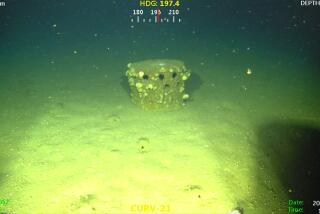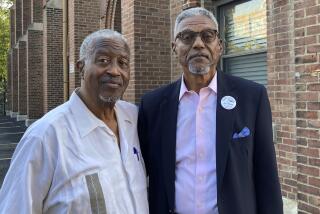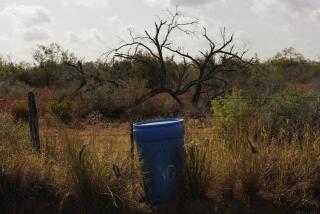Banned Weapons Remain Unseen Foe
CAMP SLAYER, Iraq â The latest U.S. intelligence, presented at a morning briefing here Friday and backed by satellite photos and reconnaissance reports, was specific and unnerving.
Saddam Hussein, a team of U.S. and Australian weapons hunters was told, may have built drone aircraft rigged with nozzles to spray poison gases, plus two short-range missiles with warheads designed to carry deadly chemicals or germs, at the former Ibn Firnas aeronautics research center.
The teamâs mission: Find the drones and use portable X-ray gear to peer into the warheads.
Donning flak vests and helmets, and loading their weapons, the 26-member team climbed into six Humvees and SUVs and sped to the sprawling complex just north of the reeking trash mountains of the Baghdad city dump.
They quickly found the âdronesâ: five burned and blackened 9-foot wings dumped near the front gate. âIt could have been a student project, or maybe a model,â the teamâs expert, U.S. Air Force Capt. Libbie Boehm, said with a shrug.
The âmissilesâ were found too, after a bit of searching through a junk heap: two discarded casings of artillery rockets.
Not everyone was disappointed. Ignoring the soldiers, a dozen or so bedraggled looters pillaged the siteâs 17 bombed buildings. They soon rode off with two donkey carts and a flatbed truck filled with broken radio parts, twisted window frames and other scrap.
âThe looters had a better day than we did,â said Lt. Col. Michael Kingsford as he ordered his team to head home. âOne thing I can say for sure is thereâs no smoking gun here.â
Frustration is routine for the men and women on the front lines of the search for Husseinâs suspected stockpiles of illicit weapons. Five days of living with them offered a vivid view of a high-profile hunt that remains in serious disarray nearly three months after the war began.
After visiting more than 300 suspect Iraqi facilities, from pesticide plants to hospital laboratories, the weapons teams have hit all the priority sites identified before the war by U.S. intelligence. Most were so heavily bombed or looted that any potential evidence was long gone.
Moreover, the teams have largely visited the same sites that U.N. inspectors searched last winter without result. They were never given any of the U.N. reports, so knew little about what was there before. Commanders have made such comparison more difficult by changing the names of some long-known U.N. sites.
Facing mounting criticism for the failure to find any unconventional weapons so far, the Pentagon is in the process of transferring responsibility for the hunt from the Armyâs 75th Exploitation Task Force to the new Iraq Survey Group -- the third and most ambitious reconfiguration since mid-March. But the transition, which wonât be completed before mid-July, has created new delays and confusion.
The reorganization, commanders say, will help them find the weapons of mass destruction that the Bush administration has insisted are hidden in Iraq. For now, however, much of the hunt is on hold as weapons teams await new people, training and orders.
Several of the seven current âsensitive site teams,â or SSTs, conducted their last mission June 2 and have been told not to expect another until June 25 or later. Dozens of team members now spend each day washing clothes, taking naps and fighting boredom.
âWeâre here to answer the big question,â said Lt. Cody Strong, a tactical intelligence officer. âYouâd think if this was really a priority, weâd have nonstop missions.â
Not all work has stopped. Two other missile and drone-hunting teams were in northern Iraq all week, and two sensitive site teams were sent Thursday to help interrogate a suspect in Baghdad.
An additional site team returned Wednesday from a grueling four-day trip to 15 sites in southern Iraq, the final ones on their target roster. In many cases, intelligence folders prepared for each site failed to note that bombing had turned the target to rubble.
âItâs kind of frustrating -- futile really -- for us to drive eight hours to check out a crater,â said Marine Lt. Col. Robert Q. Rowsey, commander of the team. âAll of our targets were put on a list before the war.â
Other team leaders complained that most intelligence folders appeared to be based solely on analysis of satellite imagery. Again and again, the intelligence proved wildly off-base.
âThe target folder for Udayâs palace at Lake Habbaniyah was real clean,â said U.S. Army Maj. Ronald Hann Jr., a highly decorated arms control expert who heads SST-6, referring to a complex for Husseinâs older son. â âThereâs the warehouse. Thereâs the poison gas storage tanks.â Well, the warehouse was a carport. It still had two cars inside. And the tanks had propane for the kitchen.â
A veteran U.S. intelligence official here said he is furious over the inaccurate intelligence reports that have sent weapons teams racing to a series of empty sites.
âIâm sitting here, and frustrated isnât the word anymore,â said the official, who has a senior role in the hunt and spoke on condition of anonymity. âI feel almost duped.â
The Iraq Survey Group hopes to change all that. Instead of revisiting old U.N. sites, the group will focus on interviewing Iraqis and analyzing documents that already fill three warehouses. The goal is to find fresh clues about any lethal microbes or chemical agents, long-range missiles or enrichment technology for nuclear weapons -- all forbidden to Iraq under U.N. resolutions.
The intelligence officer said that common-sense approach should have been taken long ago. âThese guys are reinventing the obvious,â he said. âAnd that means they didnât see the obvious before.â
Maj. Gen. Keith Dayton, who ran a Defense Intelligence Agency program that debriefed Iraqi defectors before the war, arrived Tuesday as head of the Iraq Survey Group. He declined an interview request, but a spokesman, Ken Gerhart, said the new search for clues has produced âvery promising results.â
Navy Capt. Richard Weyrich, who directs 18 rocket scientists, intelligence analysts, chemical weapons and biowarfare experts who have been waiting here since March to disable or destroy unconventional weapons, also defended the new plan.
âWhat we have been doing to this point is just going through a target list,â Weyrich said. âThe Iraq Survey Group is bringing the 50-pound brains. They can bring us the intelligence to follow the clues from one place to the next.â
The weapons hunt is based here at Camp Slayer, a former Hussein palace complex near the Baghdad airport that also holds U.S. eavesdropping and other classified operations. Two Iraqi trucks that the CIA says are most likely mobile biowarfare production facilities are stored here. There is also a stockade for some of the Iraqi weapons scientists and other top regime officials in custody.
Once renovations are done, Dayton and his staff, including a White House aide, will work in Husseinâs Perfume Palace. The ornate building has a lagoon-like indoor pool on the ground floor, huge military murals on the second and a cavernous blue-domed ballroom on top.
The rest of the camp is equally odd.
Most of the 1,200 or so troops here, plus CIA and FBI officials, covert Special Forces teams, civilian experts and others, camp in two dozen or so garish guest houses that line three artificial lakes. Others bunk in a palace that boasts its own underground bunker, complete with thick steel doors and gold wallpaper. At night, street lights designed to look like gas lamps twinkle in the gloom.
All the buildings were hit by looters, and most have no air conditioning or running water. Soldiers have furnished their oven-like accommodations with glittering chandeliers, wingback chairs, gilt-edged tables and pieces of Saddam-kitsch sculpture scavenged from the complexâs five major palaces.
Some troops live in what they believe was a brothel. Now called the Fishbowl, it features marble fish cascading along the staircase, a fireplace in the gaping mouth of a giant carved carp, and blue-green glass in the roof that casts an aquarium-like glow on those below. Others have taken up residence in what they call Bedrock, a Flintstones-like playground of tiny cave condos carved into fake cliffs and boulders.
By all accounts, the Pentagonâs first weapons-hunting plan was based on the assumption that U.S. forces battling to Baghdad would find a vast array of banned weapons, components and production facilities.
âFrankly, we expected to find large warehouses full of chemical or biological weapons, or delivery systems,â said Army Col. John Connell, who heads the sensitive site teams. âAt this point, weâre getting fairly sure weâre not going to find a full-up production facility. Weâre going to find little pieces.â
During the war, four teams trained by the CIA followed combat troops to assess any weapons caches found. If they detected lethal chemicals or germs, they were to call in separate âmobile exploitation teamsâ to collect samples and conduct field tests. If they confirmed a find, they could call a third set of teams to disable or eliminate the weapons.
No illicit arms were found. And shortages of Arabic translators and interrogators, as well as radios, vehicles and helicopters, meant teams were largely unable to investigate on their own.
The teams were reorganized, retrained and restaffed with intelligence officers, mostly from the Utah National Guard, after major combat ended in mid-April. These new SSTs spent the next six weeks visiting about 300 sites from the prewar target list.
United Nations weapons inspectors -- relying in part on intelligence handed over by the CIA -- already had searched most of the sites without result shortly before the war, senior officials here said.
âWe havenât closed anything, but weâre almost at the point now of putting a red line through the target list,â said Brig. Gen. Steve Meekin, the top-ranking Australian in the Iraq Survey Group. âMost have been comprehensively looted or bombed, and thereâs absolutely nothing there now anyway.â
Meekin, a lanky man with a bone-crushing handshake, said the Iraq Survey Group has no access to the million-page Iraqi weapons database compiled by U.N. inspectors. He said the group does have Baghdadâs weapons declarations to the U.N. Security Council as well as âall the documents on the U.N. Web site.â
Even so, search team leaders said they have little information about what sites U.N. inspectors visited or what they found.
Army Lt. Col. Keith Harrington, a wiry former Green Beret who heads SST-5, recently found 16 barrels of what he believes may be uranium oxide stored at a fertilizer factory at Al Qaim near the Syrian border in western Iraq. He still wonders why U.N. nuclear inspectors who visited the site scores of times left the drums behind.
âWe didnât have their file,â Harrington said. âWould it have helped? Absolutely.â
Confusing matters further, military and intelligence officials in charge of the hunt have renamed some Iraqi sites that were intensely investigated by U.N. inspectors.
For example, an exploitation team was sent last week to âSamarraâ to check a report of material contaminated by mustard gas, a blister agent.
They discovered two bunkers sealed long ago by U.N. inspectors at the Muthana State Establishment, which in the 1980s was the heart of Iraqâs chemical weapons program. U.S. Army Rangers had broken into one of the U.N. bunkers and reported the suspect material inside.
Few here deny the problems, and most say they still believe they ultimately will find evidence of proscribed weapons, even if itâs only leftovers from Husseinâs 1980s programs.
All proudly cite discoveries of stockpiles of conventional munitions, short-range missiles, and other weapons that Iraq was permitted to possess under U.N. resolutions. They say the new policy -- to rely more on local tips than on outdated search lists -- already is paying off.
Last month, for example, an Iraqi farmer pointed Hannâs SST-6 team to a rock quarry where thousands of antiaircraft, air-to-ground and other missiles and bombs have been stashed away since the 1991 Persian Gulf War. Looters had ripped open the packing crates to steal the wood, and hundreds of missiles lay strewn in the dirt.
âMy jaw dropped,â Hann said.
These days, Hann does what he can to keep his 12-member site team sharp. But the pickings are slim.
On Monday, a planned visit to the nearby firing range was cut short because of a scheduling glitch. A training mission Tuesday to three Republican Guard bunkers, supposedly filled with live munitions, was aborted when the team found that bombing had left the bunkers too dangerous to enter.
On Wednesday, the team donned flak vests and helmets to drive Humvees into Baghdad to buy a fan. On Thursday, they mounted up again to drive to the airport PX to buy Cokes.
âI hate to say it, but there are just days when we donât do anything,â Hann said.
More to Read
Sign up for Essential California
The most important California stories and recommendations in your inbox every morning.
You may occasionally receive promotional content from the Los Angeles Times.











